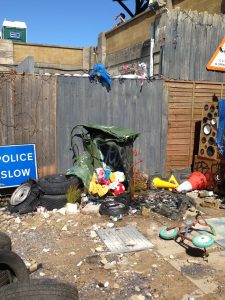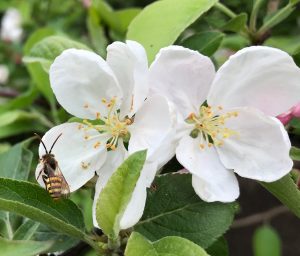Imagine if you went to a restaurant and were served plastic vegetables? And when you complained the chef said that they were less maintenance, didn’t need washing and would never go off. Would you eat them? Would you think, oh wow, that’s a great idea, another way to circumvent nature? I don’t think so. But plastic is out of control. Maybe it’s a weapon of war to slowly poison our planet and our bodies: A silent killer that we have welcomed into our homes, our gardens and our lives. It was a breakthrough of science, hailed as a life-changing material (very apt) and a by-product of oil. But it’s yet another symptom of our throwaway society, with little regard for nature.
Early warning
The signs were there. It started with the Terror of the Autons, a Doctor Who series that had plastic daffodils that spray a plastic film over the recipients face and suffocates them. How prophetic. We should have heeded the warning then. But instead it seems to have started a plastic by stealth campaign.
Ocean giant

In just fifty years we have managed to smother the whole planet in plastic. Our oceans are full of it. There are massive islands of plastic bottles in the Pacific. One is three times the size of France. It’s been given a name The Great Pacific Garbage Patch. The trouble is it’s not great, except in its size. It’s thought to be 1.6 million square kilometers. Plastic floats and is resilient in a marine environment. But in time it breaks down into micro plastics that are ingested by sea life and enter the food chain. So our food is rich in plastic particles. Our beaches are liberally seasoned with nurdles, small pieces of plastic that have washed up from degrading plastic out at sea. And now scientists think that we have plastic in our blood stream.
Fake gardens
Of course plastic has practical uses. But we need to revere it rather than discard it. Reuse and recycle are well-used mantras, especially in gardening, but there’s a giant elephant in the garden. Artificial grass. Actually it started long before artificial grass was the backdrop for greengrocers trying to green up their fruit and veg displays. It came in by stealth, offering fake topiary balls, artificial flowers and even faux hanging basket displays. Assuaged with the thinking that they were ideal for time pressed homeowners or those less able to create a garden, they started to spread. The plastic evergreen effect was almost acceptable for balconies and window boxes and old people’s care-homes. Maybe they did emit a suffocating film that addled our brains?
And now it’s another boom and bust trend. A bit like the garden decking that smothered a tranche of 90’s gardens and is now disintegrating into the rat infested labyrinth below. But there’s something very sinister about the artificial grass. Perhaps it has a place aesthetically in very small areas in contemporary gardens, But NEVER as a replacement for our lawns; the very heart of our gardens and an essential habitat for so much biodiversity.
Suffocating Earth

It’s a thick layer of plastic. It will sweat in hot weather, capture the droppings of soaring birds and divide the soil from the air so that nature cannot bridge the gap. It needs cleaning instead of mowing? It won’t stop the invasive weeds that will germinate given any chance or push through from below. It will ruck up like any large carpet and prevent the natural degradation of petals and leaves that will fall onto it throughout the season. Instead of a robot mower, you will be outside with a hoover, probably more frequently.
And what about the worms and the soil microbes? How will the robins and blackbirds scuffle about for grubs? Where will the butterflies and moths lay their eggs? What will the bees feed on when the flowers are absent? Where will the mining bees nest?
My heart breaks.
Free service

Nature is so underappreciated. It doesn’t charge us for the work that it does in decomposition, pest control and vital pollination. Maybe we would value it more if it did. We would want our money’s worth. But because it’s free and happens around us without much fuss we don’t notice, we don’t appreciate and many don’t actually care. Financial experts* estimate that the value of nature’s pollination service is £135 billion!! Or £87 per household.
Never mind. Scientists can invent artificial bees. It’s happening already. Robot bees are on the agenda. But we’d need millions of them and that means fresh valuable resources being used to create tiny little drones, so aptly named! If only the same funding was being used to help preserve, protect and save our precious pollinators.
In China fruit trees are being pollinated by hand. It’s a sobering landscape in places, devoid of pollinators. Instead children with bags of pollen and paintbrushes climb the trees to add pollen to the flowers. I could weep.
* (Ref Jonathan Guthrie Nature Therapy Financial Times).










